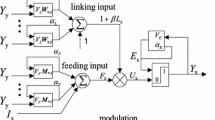Abstract
This paper presents a novel iterative thresholding segmentation method based on a modified pulse coupled neural network (PCNN) for partitioning pixels carefully into a corresponding cluster. In the modified model, we initially simplify the two inputs of the original PCNN, and then construct a global neural threshold instead of the original threshold under the specified condition that the neuron will keep on firing once it begins. This threshold is shown to be the cluster center of a region in which corresponding neurons fire, and which can be adaptively updated as soon as neighboring neurons are captured. We then propose a method for automatically adjusting the linking coefficient based on the minimum weighted center distance function. Through iteration, the threshold can be made to converge at the possible real center of object region, thus ensuring that the final result will be obtained automatically. Finally, experiments on several infrared images demonstrate the efficiency of our proposed model. Moreover, based on comparisons with two efficient thresholding methods, a number of PCNN-based models show that our proposed model can segment images with high performance.


















Similar content being viewed by others
References
Sezgin M, Sankur B (2004) Survey over image thresholding techniques and quantitative performance evaluation. J Electron Imaging 13(1):146–165
Skourikhine AN, Prasad L, Schlei BR (2000) Neural network for image semgentaiton. In: Proceedings of SPIE, SanDiego, Calif, pp 28–35
Osher S, Fedkiw RP (2001) Level set methods: an overview and some recent results. J Comput Phys 169(2):463–502
Eckhorn R, Reitboeck HJ, Arndt M, Dicke P (1990) Feature linking via synchronization among distributed assemblies: simulations of results from cat visual cortex. Neural Comput 2(3):293–307
Li M, Cai W, Li X (2006) An adaptive image segmentation method based on a modified pulse coupled nerual network. Lecture Notes Comput Sci 4221:471–474
Shi M, Jiang S, Wang H (2009) A simplified pulse-coupled neural network for adaptive segmentation of fabric defects. Mach Vis Appl 20:131–138
Ma Y, Dai R, Li L, Wei L (2002) Image segmentation of embryonic plant cell using pulse-coupled neural networks. Chin Sci Bull 47(2):167–172
Rava TH, Bettaiah V, Ranganath HS (2011) Adaptive pulse coupled neural network parameters for image segmentation. World Acad Sci Eng Technol 73:1046–1052
Wei S, Hong Q, Hou M (2011) Automatic image segmentation based on PCNN with adaptive threshold time constant. Neurocomputing 74(9):1485–1491
Chen Y, Park SK, Ma Y, Ala R (2011) A new automatic parameters setting method of a simplified PCNN for image segmentation. IEEE Trans Neural Netw 22(6):880–892
Fu JC, Chen CC, Chai JW, Wong STC, Li IC (2010) Image segmentation by EM-based adaptive pulse coupled neural networks in brain magnetic resonance imaging. Comput Med Imaging Graph 34(4):308–320
Ma Y, Liu L, Zhan K, Wu Y (2010) Pulse-coupled neural networks and one-class support vector machines for geometry invariant texture retrieval. Image Vis Comput 28(11):1524–1529
Kong X, Huang J, Shi H (2001) Infrared image multi-threshold segmentation algorithm based on improved pulse coupled neural networks. J Infrared Millim Waves 20(5):365–369
Kuntimad G, Ranganath HS (1999) Perfect image segmentation using pulse coupled neural networks. IEEE Trans Neural Netw 10(3):591–598
Fang Y, Qi FH, Pei BZ (2005) PCNN implementation and applications in image processing. J Infrared Millim Waves 24(4):291–295
Stewart RD, Fermin I, Opper M (2002) Region growing with pulse-coupled neural networks: an alternative to seeded region growing. IEEE Trans Neural Netw 13(6):1557–1562
Bi Y, Qiu T (2005) Adatpive image segmentation method based on a simplified PCNN. Aca Electronica Sinica 33(4):647–650
Zhao Z, Zhao C, Zhang Z (2007) New method of PCNN’s parameter’s optimization. Aca Electronica Sinica 35(5):996–1000
Ma Y, Dai R, Li L (2002) Automated image segmentation using pulse coupled neural networks and images entropy. J China Inst Commun 23(1):46–51
Ma Y, Liu Q, Qian Z (2004) Automated image segmentation using improved PCNN model based on cross-entropy. In: Proceedings of, 2004 International Symposium on Intelligent Multimedia, Video and Speech Processing, Hong Kong, China, pp 743–746
Qi Y, Huo Y, Zhang J (2008) A automaic image segmentation method based on simplified PCNN and minimum scatter within cluster. J Optoelectron Lazer 19(9):1258–1261
Zhan K, Zhang H, Ma Y (2009) New spiking cortical model for invariant texture retrieval and image processing. IEEE Trans Neural Netw 20(12):1980–1986
Kinser JM (2002) A simplified pulse-coupled neural network. In: Proceeding of SPIE, Orlando FL, USA, pp 563–567
Otsu N (1979) A threshold selection method from gray-level histogram. IEEE Trans Syst Man Cybern 9(1):62–66
Bazi Y, Bruzzone L, Melgani F (2007) Image thresholding based on the EM algorithm and the generalized Gaussion distribution. Pattern Recognit 40(2):619–634
Ma Y, Qi C (2006) Study of automated PCNN system based on genetic algorithm. J Syst Simul 18(3):722–725
Acknowledgments
The authors would like to thank the reviewers for very helpful comments and suggestions. This work has been supported by the grants of the Science Foundation of Ministry of Education, No. 20090191110026, and the Fundamental Research Funds for the Central Universities, No. CDJXS11120022.
Author information
Authors and Affiliations
Corresponding author
Rights and permissions
About this article
Cite this article
Gao, C., Zhou, D. & Guo, Y. An Iterative Thresholding Segmentation Model Using a Modified Pulse Coupled Neural Network. Neural Process Lett 39, 81–95 (2014). https://doi.org/10.1007/s11063-013-9291-z
Published:
Issue Date:
DOI: https://doi.org/10.1007/s11063-013-9291-z




